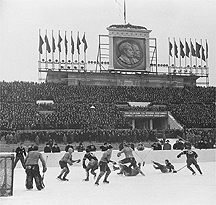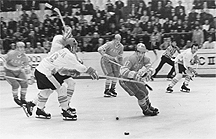

1957-1974  The vice presidents elected in the first era after the war were Dr. Kraatz (1946–47 and again 1948–1951), Josef Loss from Czechoslovakia (1947–1948), George Hardy from Canada (1947–1948), Walter Brown from USA (1948–1954), John "Bunny" Ahearne from Great Britain (1951–1957) and George Dudley from USA (1954–1960). With the American Walter Brown, for the first time in 1954 a professional ice sport manager was elected president of the federation – which meanwhile had adopted the English name "International Ice Hockey Federation" (IIHF). Contrary to his ambitions, Brown’s term of office remained limited to three years. His successor John Ahearne, an Irish native living in London, who was acting at first from 1957 to 1960 (and later on in another term of office), could equally be classified as a professional sports manager, although his main activity was to run a travel agency, through which he skilfully and successfully combined sport and travel.
In the life of the IIHF, the decade between 1954 and 1963 marked a period of consolidation. For a while, uneasiness was caused merely by the political events in the autumn of 1956 (Hungarian revolt, Suez crisis), which resulted in the fact that the 1957 world championship in Moscow was boycotted by most of the "western" countries.
From 1960 to 1964, the number of IIHF members was extended mainly in the Asian region: China, the Democratic People’s Republic of Korea (North Korea) and the Korean Republic (South Korea) were added, as well as Bulgaria as another member from Europe.
The IIHF was headed from 1960–1963 by the Canadian Robert Lebel, 1963–66 again by Ahearne, 1966–69 by the American William Thayer Tutt. Ahearne (1960–63), Brown (1960–63) and Thayer Tutt (1963–69) acted from time to time also as vice presidents, from 1957–66 in addition the Swede Rudolf Eklöw.
The congresses were held as a rule at the venue of the world championships, with the exception of Rimini (Italy) in 1960, Montana (Switzerland) in 1963 and Pörtschach (Austria) in 1966.
A little more momentous in comparison was the boycott of the 1962 world championship. After the erection of the Berlin Wall in the summer of 1961, USA in its capacity as the hosting country refused the entry to the GDR representation. In solidarity with their "brother country", the countries of the "socialist camp" all together did not come to the world championship, and because of the absence of the Soviet Union and of Czechoslovakia, this did matter a great deal, at least from the sports point of view.
At the present time, because of the great number of member national associations which were newly affiliated – not least because of the revolutionary political events – the deliberations are still in an experimental stage: Is it advisable to establish new pools or should pools be limited to a few only and qualification tournaments – perhaps on geographical grounds – precede the championships? The decisions which are to be made in this respect will certainly be decisive also for the further expansion of the ice hockey sport on a worldwide basis.
European Cup An enlargement of the international calendar of competitions was the introduction of a European Cup for national champions. Since a competition of that kind was successful in football and soon afterwards also in handball, in 1965 in Tampere the German delegate Dr. Sabetzki made a proposal in that direction, and this was approved with majority. Organizational difficulties and the big difference in performance between the national champion teams within Europe entailed that the European Cup never got as popular as the parallel competitions in football and handball. After 30 years of European Cup, restructuring is getting started regarding international club competitions, which will be dealt with once more later.The principle following which Europe and North America should take turns with the IIHF presidency every three years was interrupted after more than two decades in favour of John Ahearne: his third and last term of office covered the period from 1969 to 1975. |






